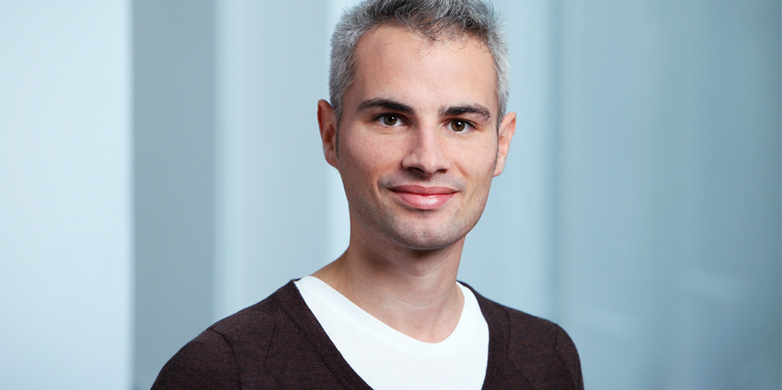Philipp Grohs receives Latsis Prize
The 33-year-old Assistant Professor Philipp Grohs is to be awarded the ETH Zurich Latsis Prize. He is being honoured for his achievements in applied mathematics. The award ceremony will take place on ETH Day.
The 33-year-old Assistant Professor Philipp Grohs is to be awarded the ETH Zurich Latsis Prize. He is being honoured for his achievements in applied mathematics. The award ceremony will take place on ETH Day.
"I didn't expect this prize. It was a big surprise to me to be chosen ahead of researchers in fields where it is easier for them to present their results to the general public," says Philipp Grohs. "On the other hand, I'm not entirely taken aback, because mathematics has now outgrown its image of being confined to dusty ivory towers. Nowadays, every technical device we use in our daily lives is based on mathematics."
The Assistant Professor at the D-MATH has won the ETH Zurich Latsis Prize 2014 at the age of just 33 for his outstanding achievements in the field of applied mathematics, especially for his contributions to approximation theory and numerics, differential and algorithmic geometry and methods of multiscale analysis. "To receive this prize from one of the best universities in the world is a huge honour," says Philipp Grohs.
ETH Zurich awards the prize, funded by the Fondation Latsis International for completed, outstanding, independent scientific work by young non-tenured researchers at ETH Zurich. The Latsis Prize can be presented for outstanding scientific work in any of the fields of research that are studied at ETH Zurich.
Decoding vast amounts of data
"My work is mainly about the efficient presentation of vast amounts of data," says Philipp Grohs. An ever increasing volume of data is being recorded data. Vast quantities of data are often available, yielding relatively little information. Philipp Grohs approaches this problem as follows: "I try to find the architecture, what you might call the building blocks for specific types of data. The building blocks for music, for example, are notes. Other types of data, such as medical imagery, stock exchange prices, Facebook profile data, text or Google search queries, all have their own architecture. If you recognise that architecture, you can use it to present complex data efficiently and extract information from it."
Philipp Grohs has, for example, developed methods for presenting imagery from diffusion tensor magnetic resonance, an imaging procedure that uses magnetic resonance tomography (MRT) to measure the diffusion movement of water molecules in body tissues and show it in spatial resolution.
He has also discovered innovative ways of representing and simulating liquid crystals. This kind of simulation is required for the development of LCD screens, for instance.
The mathematician also studies gas simulation and flow dynamics. This is useful, for example, in simulating the aerodynamic flow around aircraft wings. "I think it's great that mathematics plays such a crucial role in this kind of thing." That's what first got him excited about applied mathematics: "While studying for my degree, I was still mainly focused on theory. Then, gradually, I began to realise that most new developments in mathematics are based on real physical problems." The breadth of his training stands him in good stead: "One of my strengths is being able to combine the methods from different areas of mathematics to find new results."
Now he works at the interface between computer science and mathematics: "The role of mathematics is to make sure the methods are correct, so that no vital information goes missing and the computer simulations really do reflect reality."
Postdoc in Saudi Arabia
Philipp Grohs was born in Austria and studied at the Technical University of Vienna. After completing his thesis, he spent six months as a postdoc at the King Abdullah University of Science and Technology (KAUST) in Saudi Arabia. In 2010 he switched to ETH Zurich, where he was promoted to Assistant Professor after just one year. "I didn't specifically plan things that way, but ETH Zurich is the best place to be if you want to stay in Europe," says Philipp Grohs. "It has always been important to me to be somewhere where people are leading the way in science and can stimulate one another."
The Latsis Prize is endowed with CHF 25,000. Does Philipp Grohs know what he will do with the money? "I might take a good holiday, possibly go to a yoga monastery in the Himalayas." Professionally, he has a firm target: "I want to set up a leading centre for mathematical data processing and simulation."
ETH Day 2014
ETH Rector Lino Guzzella will present Philipp Grohs with his certificate and cheque on ETH Day 2014. This will be held on 22 Saturday November. On ETH Day, ETH Zurich will invite guests from research, politics and business to celebrate the university's 159th anniversary. It is traditionally on this day that ETH Zurich presents honorary doctorates to individuals who have made outstanding contributions to international science. Students, doctoral students and lecturers are also awarded prizes for outstanding achievements.

Comments
No comments yet